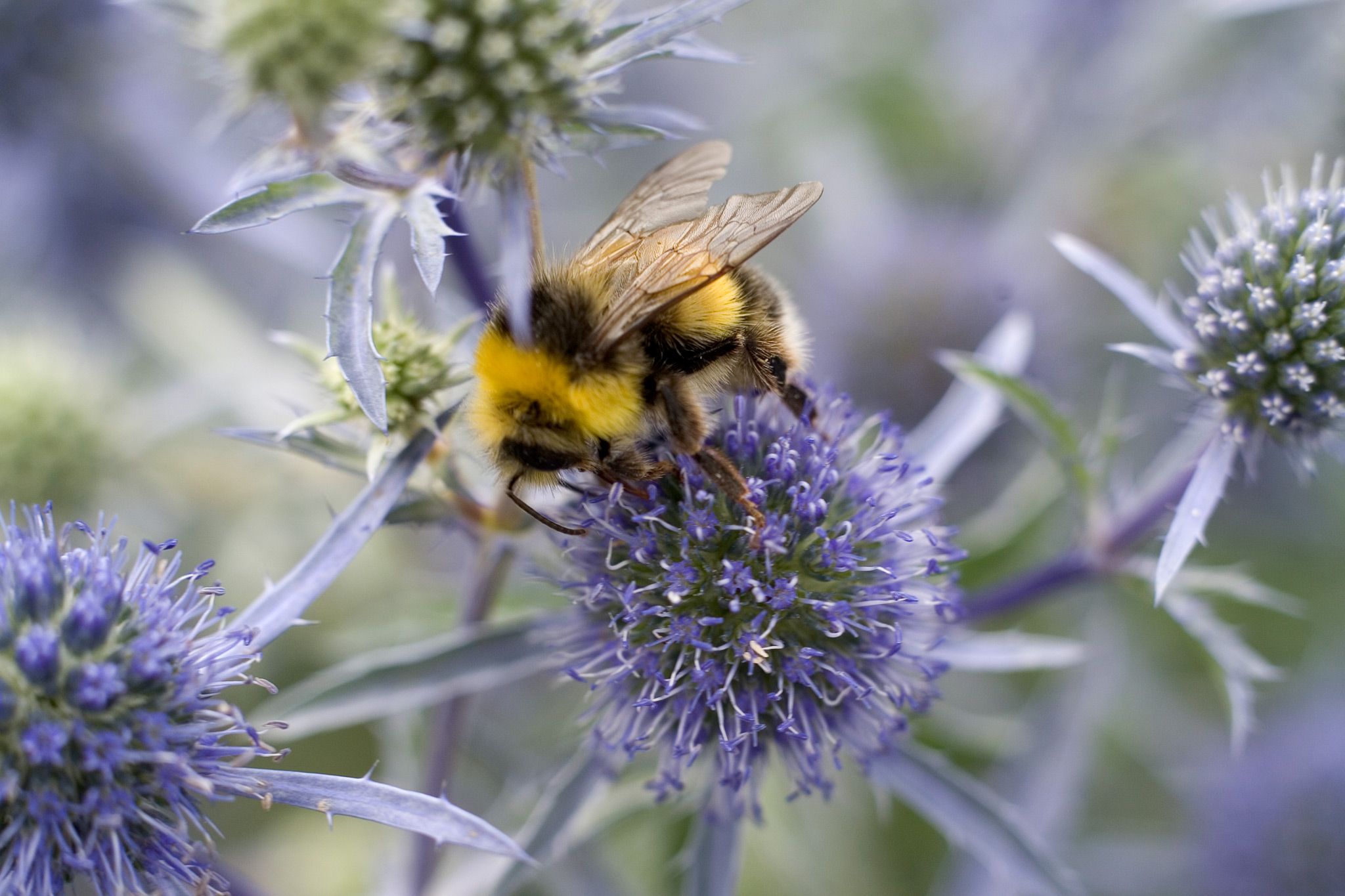|
A bee garden?
Mary Ann Ryan
Adams County Master Gardener

Bees, bees, bees! What’s all the talk about? You may have heard about the honey bee decline. Research continues to try and understand the why’s of this problem. What has been found is that many things are contributing, including bee stress from transportation of the hives around the county, mites and pesticides.
As researchers continue to learn more about the decline of the honeybee, consumers are becoming more aware of the importance of pollinators. One third of our food is a result of pollinators, which includes bees and other insects, butterflies and moths, birds and bats. However the bees are a major contributor to the pollination process, pollinating about 90% of the food.
 As a result of this decline of the honeybee, we also recognize the importance of our native bees that live here. Therefore, a push for bee habitat and food supply for these bees is now in the forefront to fighting our pollination problems. These native bees can pick up the slack that the honeybees are unable to fill. This pollination is incredibly important for our diversity of food. Why not encourage our native pollinators? As a result of this decline of the honeybee, we also recognize the importance of our native bees that live here. Therefore, a push for bee habitat and food supply for these bees is now in the forefront to fighting our pollination problems. These native bees can pick up the slack that the honeybees are unable to fill. This pollination is incredibly important for our diversity of food. Why not encourage our native pollinators?
In addition to the researchers working on the Colony Collapse Disorder (the term used to identify the honeybee problem), there is also work being done on the sustainability of our own pollinators. Plant selection and habitat are the most important things when considering attracting and maintaining our native bees and pollinators.
As a homeowner, there are many decisions we can make in our yards and gardens to support the pollinators. Choices of plants is one of the easiest things we can do to increase the pollinators that visit our gardens. Following a few simple rules will create a great place to encourage the bees to live and thrive in your garden.
- Choose flowering plants, including annuals, perennials, shrubs and trees. The more diverse the flowering time, the longer period of time pollinators will be feeding.
- When choosing plants, stay away from the double flowering types. Often in the breeding of these fancy blooming plants, the attraction of the flowers to the bees goes away.
- Choose native plants. These plants have evolved with our native insects, making them the needed food source.
- Provide water, whether it’s through a birdbath, or a bowl of rocks with water in it.
When considering the plants, here are a few you may want to try:
Picnanthemum - Mountain mint: a native plant, this is a full sun lover. It prefers moist soils and is deer resistant. This plant will move with the hustle of insects feeding on its flowers.
Agastache: There are many species and cultivars of agastache. In our trial gardens at the Ag Center in Gettysburg, we have noted many bees visiting these plants. It’s probably the most visited plant. They take full sun and well drained soils. Easy to grow, most reach about 24 – 30 inches in height.
Eupatorium purpureum, Joe Pye Weed: This very tall plant, up to six feet, likes full sun to part shade. Moist soil is preferred, but I’ve seen this grow along roadsides that appear to be on the drier side as well. Dark pink flowers cover the tops of this plant in August, and are great as a back drop to any perennial border or bed.
Solidago, Goldenrod: This fall bloomer has an undeserved bad reputation. Often thought of as ragweed, the plant everyone and their brother seem to be allergic to, goldenrod is not ragweed. Ragweed happens to bloom at the same time, but has nondescript little green flowers. Goldenrod has showy yellow-golden flowers that start blooming in late August and continue to bloom almost till frost. They are a great nectar source for migrating monarchs in the fall months as well as for the native bees.
There are many species and cultivars of goldenrod. Probably my favorite and very common cultivar of goldenrod is Solidago rugose ‘Fireworks’. This particular plant has golden flowers that burst from the tops of the plants, slightly drooping. A full sun plant, the solidagos, with the many cultivars, come is heights of 12 inches to 3 feet.
Trees should not be forgotten when selecting plants for pollinators. Oaks support over 500 types of pollinators! Blooming in spring when some herbaceous plant material is still dormant, the oak tree is a food and nesting source for many types of wildlife, whether it’s bees, birds or squirrels. Some of our native oak trees include the scarlet oak, pin oak, white oak, swamp white oak, red oak, and more. This group of trees get very large – 120 feet – and like lots of room to grow. Found in many soil types, depending on the species, be sure to know whether the soil is dry, moist or wet before determining the type of oak you plant.
Flowering trees, like redbuds, support bees. Considered a small tree, the redbud blooms in April with purple-pink flowers and reaches about 25’. Found all over the battlefield in Gettysburg, it grows along rock outcroppings and along woods’ edge. This is naturally an understory tree, so giving it part sun is ideal.
Some flowering shrubs that should be considered when developing a pollinator garden include viburnums, shrub dogwoods, spicebush and elderberries. All of these native shrubs do get to be large, so using them as a foundation plant would not be wise. However, used in a shrub border or in a garden as the backdrop to perennials will create an absolutely spectacular show.
Our native viburnums include Viburnum acerifolium, Viburnmum trilobum and Viburnum nudum. These particular viburnums like part sun and bloom in May-June. The fun thing about the viburnums is that not only are the flowers beautiful – offering white blooms, but they get pretty berries in late summer, and have a lovely fall color as well.
Viburnum acerifolium has dark purple, almost black berries and a nice red fall color. Viburnum trilobum gets red berries and red color, and Viburnum nudum (nannyberry) has blue berries with a red fall color, making all three of these species great choices for your pollinator garden.
Sambucus, otherwise known as elderberry bush, is found naturally along streams and in moist sites. Reaching up to 12 feet, this large shrub is well known for its delicious berries that are great in a pie –that is if you get to it before the birds! Filtered sun is best, but I’ve seen them quite happy in full sun as well. Be sure it has moist soils, a dry site may not be a good choice for this pretty plant. It gets white flowers and the berries are a dark purple to black color.
There are many newer selections that have been introduced. I have elderberries growing in a shrub border and it creates a great backdrop to other flowering plants in the area. I see lots of insects buzzing around the flowers when in bloom. The shrub has compound leaves, making it look more delicate in form. The white flowers are really pretty when in bloom and the berries are pretty as well. Although it gets quite large, up to 10 feet, it can be a great focal point or backdrop in any garden.
In our world today, it’s important for us to re-think what we consider a "pretty" landscape. The choices we make in plant selection directly impact our life and our environment in which we live. A more "wilder" look is and should be acceptable in any neighborhood when we are providing a food source and needed habitat for our insects.
When planning your garden, consider the bees. Providing a place to live and food to eat for these insects will help our native insects in the quest for pollinating our food supply.
Read other articles on birds, wildlife & beneficial insects
Read more articles by Mary Ann Ryan |